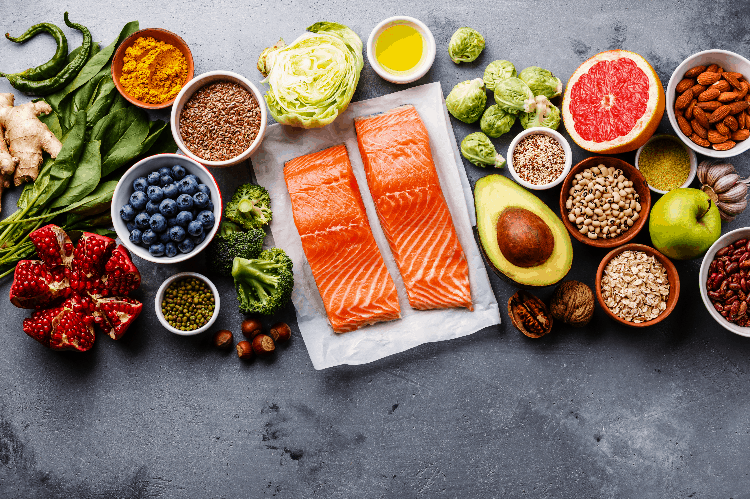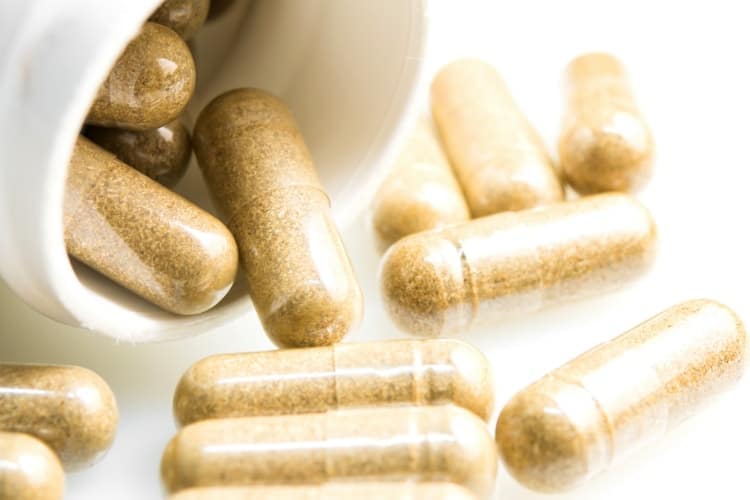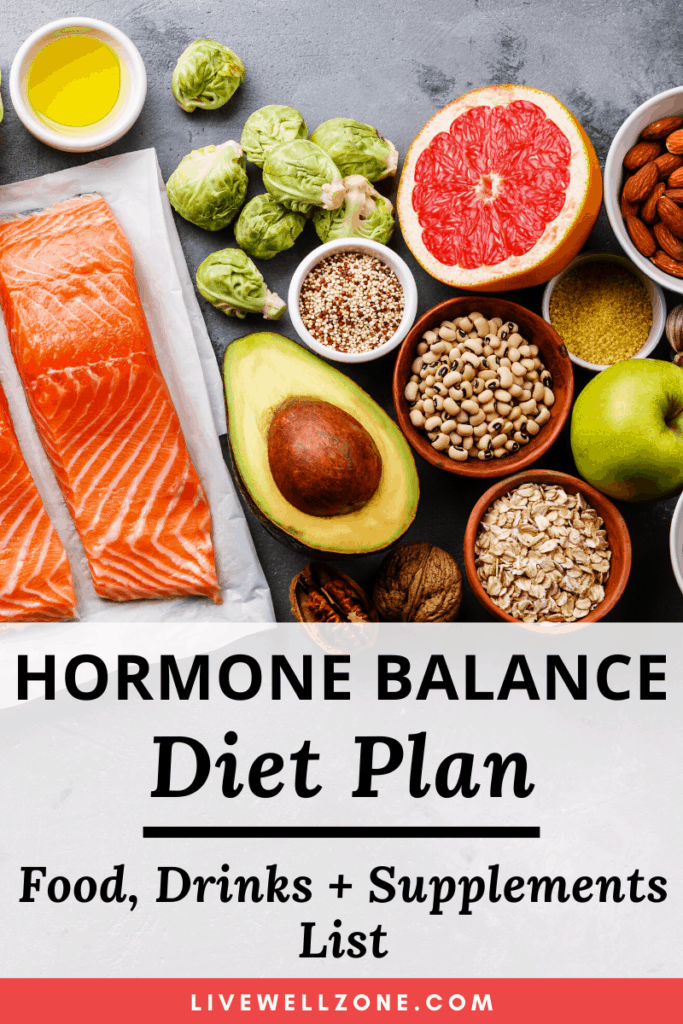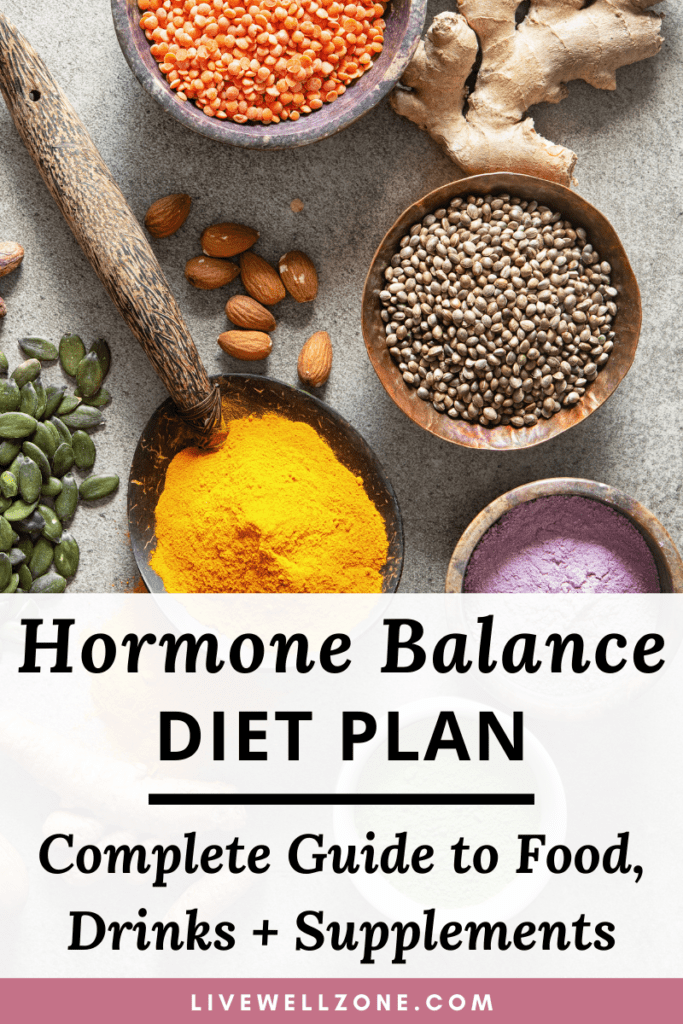
Although balancing your hormones can feel overwhelming and confusing there are really just three key things I like to keep in mind when it comes to a hormone balancing diet plan:
- Inflammation: chronic inflammation wrecks gut health and puts the body in fight-or-flight mode. Fight-or-flight results in more cortisol production and contributes to imbalances in insulin, estrogen, progesterone and more).
- Nutrient density: the more nutrients we consume the better. These nutrients help to protect us from the harmful effects of inflammation, while also nourishing the liver, gut, endocrine glands and other organs that affect hormone balance.
- Macronutrient balance: it’s important to eat a healthy balance of proteins, fats and carbs because severe restrictions of any one food group can have serious hormonal consequences. For example, severe restriction of carbs contributes to missing periods, while severe restriction of fat can affect the production of sex hormones (all of which use fat as their raw material).
With these three things in mind, I personally lean on an anti-inflammatory and nutrient-dense (whole food) plan, with a healthy balance of the 3 main food groups (protein, fats and carbohydrates).
If this is something you’d like to explore, then keep reading because this article walks you through:
- meal planning tips for hormone health.
- the food categories to focus on for hormone balance.
- supplements for hormone support.
Note: this post contains affiliate links and I earn a commission (at no additional cost to you) if you use them to make a purchase.
MEAL PLANNING TIPS FOR HORMONAL IMBALANCE
When it comes to eating for your hormones, there are so many different tips and tricks that it can all lead to overwhelm.
So, here’s a short list of the most high impact tips – i.e. they give you the highest return on your investment – to keep in mind as you plan your meals.
- Start your day with a smoothie or fresh-pressed juice. Not only are they rich in nutrients, but they’re easier to digest. This gives your body time to ease into the day without having to break down very heavy food.
- Replace soda and sugary drinks with herbal teas like hibiscus tea (which is traditionally used to support healthy menstrual cycles!). Cold hibiscus tea, with a little raw honey, is particularly refreshing in the summer!
- Replace pro-inflammatory cow’s milk with plant-based milk.
- When it comes to meats (beef, chicken, turkey) and eggs, buy organic as much as possible.
- Try to include healthy fats in all your meals. Those fats are the raw material for making all your sex hormones and adrenal hormones.
- When it comes to fish, stick to wild-caught. And prioritize fatty fish (such as mackerel, sardines and salmon) since they are anti-inflammatory and contain healthy fats.
- Eat beans more regularly (I personally like to aim for at least every other day). They’re an excellent source of healthy carbs, protein, fiber and inositol (a natural sugar that is particularly helpful for insulin resistance and PCOS).
- Include healthy carbs in all your meals because they’re essential for brain health and two major hormone-producing glands (the hypothalamus and pituitary) are located in the brain.
- Use more gluten-free grains in your meals (gluten can be pro-inflammatory, thus contributing to gut issues and hormonal imbalance).
- Whenever possible, include leafy greens in every meal. They’re anti-inflammatory, packed with nutrients and helpful for detoxification.
FOOD AND DRINK LIST FOR A HORMONE BALANCE DIET

1. Plant Proteins
Since animal foods (particularly red meat) tend to be more inflammatory, one of the quickest ways to start supporting your hormones is to eat more plant proteins.
Here are a few to choose from:
- chickpeas
- lentils
- red beans
- black beans
- pinto beans
- cannellini beans
- lima beans
- quinoa
- broccoli
- peas
Aside from the above, soy products, like tofu and edamame, are also good sources of protein.
However, everyone has a different opinion about soy. Yes, there is research showing that it can help some women (especially during menopause). But there’s also lots of concern about soy’s phytoestrogen content.
In addition, most of the soy on the market is genetically modified. And that GMO soy can actually be sprayed with a lot more pesticides than non-GMO soy…which means you end up with more pesticide residue.
So, should you avoid soy completely? This is ultimately a personal decision because there are plenty of countries that have historically consumed soy and done just fine health-wise.
If you do decide to add soy in your diet, keep these tips in mind:
- choose organic.
- eat more fermented forms of soy (such as natto, tempeh, miso, fermented tofu). Many Asian countries that eat soy regularly tend to favor the fermented kind.
2. Probiotic-rich Foods
Fermented foods contain probiotics which increase the amount of friendly bacteria in your gut.
This goes a long way for hormone health because the gut makes hormones and also plays a role in detoxification.
Some probiotic-rich foods to choose from are:
- coconut yogurt.
- sauerkraut and other fermented veggies.
- organic (cow’s milk) yogurt.
3. Gluten-Free Grains
Although wheat isn’t inherently bad, it can be inflammatory for some people. And most of all, the ways in which wheat is grown and processed nowadays can contribute to inflammation.
Since inflammation increases cortisol and puts added stress on the adrenal glands, it’s often a good idea to stay away from gluten-containing grains while your body is recovering.
Some gluten-free grains to include in your diet are:
- rolled oats
- brown rice
- white rice
- quinoa
- spelt
- amaranth
- buckwheat
- millet
- teff
- sorghum
4. Whole Fruits and Veggies
I know we’re all tired of hearing that we have to eat more fruits and veggies. But the fact is, we really do 🙂
In the same way that firemen rely on water to put out a fire, our bodies need the antioxidants, vitamins and minerals from fruits and veggies to cool down the inflammatory flames in our bodies.
So, don’t hesitate to load up on this category of foods.
Now, one sub-category of veggies that can be especially helpful for hormones is cruciferous veggies. These veggies contain sulfur, which the body uses to make glutathione (an important detoxifier that binds to toxins and escorts them out of the body.
There’s no shortage of fruits and veggies to choose from so the list below highlights just a few:
- berries (strawberries, blueberries, blackberries, raspberries)
- sweet cherries
- avocado
- watermelon
- bananas
- oranges
- apples
- pears
- kiwi
- cruciferous vegetables (cabbage, cauliflower, broccoli, kale and so on)
- cucumbers
- spinach
- tomatoes
- beets
5. Herbs and Spices
Not only do spices and herbs help to fight off inflammation, but some – such as with cilantro, parsley and ginger – are well known for supporting detoxification.
So, feel free to use any herbs and spices that you personally enjoy.
As for salts, avoid refined table salt and stick to wholesome kinds (sea salt, pink salt, red Hawaiian salt). These types of salts contain trace minerals that are absent from table salt. So, nutritionally, they’re better for you.
Here are a few herbs and spices to consider using regularly:
- ginger
- cilantro
- parsley
- cinnamon (this article gives you more on the benefits of cinnamon for hormone balance)
- clove (read this to learn how cloves help with menstrual cramps).
- mint (cooling herb that can be very helpful for hot flashes)
- turmeric (this guide covers the many ways turmeric supports hormones).
6. Fatty Fish
Fatty fish contain omega-3 fatty acids which the body needs to make hormones and fight inflammation.
When choosing your fish, stay away from farmed fish.
It contains a whole lot of chemicals that your body simply doesn’t need.
Instead, go for wild-caught fish.
Choose from:
- salmon
- sardines
- mackerel
- seabass
- trout
7. Organic Meat
The most important thing when choosing any meats is that they should be organic, antibiotic-free and hormone-free varieties.
You can choose from:
- grass-fed beef
- chicken
- turkey
- lamb
Also, be aware that meat takes a lot more effort to digest (compared to plant proteins or even fish). And since we want to reduce the amount of stress on the body, it’s important to consume meat just a few times a week.
Having said that, everyone’s protein needs are different. So you’ll have to do some trial and error to figure out what “a few times a week looks like for you.”
In addition, while we’re on the topic of meat, bone broth is a fantastic source of healing nutrients for the gut. It’s packed with minerals and 17 different amino acids – including collagen (source)!
And unlike eating actual meat, bone broth is easy on the digestive system because it’s a liquid.
So, definitely consider adding bone broth to your hormone balance diet plan. You can make your own or buy it – but just make sure it’s made from the bones of grass-fed, antibiotic-free and hormone-free cows.
8. Plant-based Milk
Plant-based milks are a healthier, anti-inflammatory source of proteins compared to cow milk.
So, it’s a good idea to choose from one or more of these milks to support your body:
- almond milk
- oat milk
- cashew milk
- macadamia nut milk
- rice milk
- pea milk
Be aware that many brands use undesirable additives and preservatives in plant milks.
So you’ll have to shop around for clean brands (like Three Trees) or make your own milk (you can find my almond milk recipe here).
However, if neither of the above options are practical for you, then just buy what’s available to you.
As long as you’re reducing your toxic load from other sources and eating other nutrient-rich foods, your body will make progress.
9. Oils and Fats
When it comes to oils, you simply want to go for cold-pressed, non-hydrogenated ones. Some of the best oils to use include:
- grapeseed oil
- palm oil
- organic butter
- ghee
- unrefined avocado oil
- extra virgin olive oil
- unrefined coconut oil
- hemp seed oil
10. Gluten-Free Baking Flours
Earlier we talked about eating gluten-free grains to keep stress and inflammation low. The same thing applies to flour.
Luckily, gluten-free flours have become more mainstream and easy to find. Some to add to your diet are:
- almond flour
- coconut flour
- garbanzo flour
- brown rice flour
- spelt flour
- buckwheat flour
11. Raw Nuts and Seeds
Raw nuts and seeds are excellent sources of proteins and healthy fats (which are needed to make hormones, as well as to support the gut and liver).
The main ones to add to your diet include:
- almonds
- walnuts
- macadamias
- cashews
- peanuts
- chia seeds
- flax seeds
- sesame seeds
- pumpkin seeds
- sunflower seeds
12. Natural and Unrefined Sweeteners
Refined sugar is one of the most pro-inflammatory, hormone-disruptive foods in our food supply.
So, for hormone health, use only natural and unprocessed sweeteners like:
- raw honey
- pure maple syrup
- molasses
- unrefined green stevia leaves or powder (NOT stevia drops or other types of refined white stevia)
- date sugar
13. Drinks
Some of the best drinks for supporting hormone health include:
- Fresh pressed juices.
- Smoothies.
- Kombucha: fermented tea that contains probiotics.
- Diluted apple cider vinegar: research suggests that it may support ovulation and improve insulin resistance in women with PCOS.
- Green tea.
For a detailed breakdown of these drinks and some recipes to use, please read this guide on drinks for hormone balance.
VITAMINS AND SUPPLEMENTS TO SUPPORT YOUR HORMONE BALANCE MEAL PLAN

Although supplements are not a substitute for a healthy diet, the right ones can definitely help you feel better faster as you work on longer term dietary changes.
Some of the best supplements for supporting hormonal imbalance include:
- Shatavari: known as the “Queen of Herbs” in Ayurveda; traditionally used to balance the menstrual cycle and support female hormones during all phases of life.
- Maca: traditionally used to support the menstrual cycle and fertility; during menopause it may help improve libido and vaginal dryness.
- Matcha green tea: lowers excess testosterone; regulates blood sugar and improves insulin sensitivity; cools inflammation.
- Vitex (aka chasteberry): supports ovulation; lowers elevated prolactin; increases progesterone and may help with short luteal phase.
- Cinnamon: regulates blood sugar; soothes cramps; may support ovulation.
- Turmeric: anti-inflammatory; helps with insulin resistance; supports liver health.
- Green algae (such as kelp, spirulina and chlorella): very nutrient dense; rich in proteins; anti-inflammatory; supports detoxification.
- Vitamin D: supports thyroid function; supports fertility; regulates blood sugar.
- B-vitamins: involved in just about every aspect of our health including fertilization, implantation, regulating blood sugar, improving mood swings, supporting thyroid and adrenal function…and much more!
As for actual products that contain these ingredients, here are my 7 favorites.
HORMONE BALANCING FOOD PLAN FOR MENOPAUSE: ADDITIONAL CONSIDERATIONS
Although each woman’s experience with menopause is unique, some of the major concerns that many women face include:
- weight gain.
- sleep disruption.
- hot flashes.
- mood swings.
These symptoms are not unique to menopause and therefore, the hormone balance food plan that we’ve already looked at is an important foundation.
That said, there are some nuances that you still want to be aware of during menopause. For example:
- estrogen isn’t the only hormone to focus on. Progesterone, insulin and cortisol also contribute significantly to how you feel during menopause.
- contrary to popular belief estrogen isn’t always low as you go into menopause. In fact, some research shows that during perimenopause estrogen can actually be quite high (even higher than during our younger years).
- loading up on phytoestrogen-rich food won’t automatically fix everything. Your diet still needs to be well-rounded.
To dive deeper into these topics, here are some additional resources for you:
- Perimenopause Diet: A Definitive Guide for Weight, Energy, Sleep & More
- Everything You Need To Know About Estrogen Dominance During Perimenopause
- How to Go Through Menopause Naturally: 7 Steps To Start Using Today
FAQs ABOUT HORMONAL IMBALANCE DIET PLAN
How long does it take to balance hormones with diet?
Some of the women who have followed my DIY programs and private coaching program have experienced noticeable improvements within a week, resulting in more energy, better sleep, weight loss and a significant reduction of chronic pain.
For others, it took several weeks to notice improvements in PMS and other cycle-related imbalances (such as cramps and bloating).
CONCLUSION
We covered a lot of ground in this guide. As you can see, the goal is to prioritize whole foods. This is the easiest way to support the systems and organs that affect the endocrine system.
Now, if you’d like to dive into more specific topics, below are some additional resources that will help you put together meals that work for you:
- Easy Breakfast Ideas for Balancing Hormones.
- Juicing For Hormone Imbalance: A Complete Guide for Beginners.
- Low Carb Diets and Hormones: What You Probably Don’t Know
- Hormone Balancing Foods for PCOS


You Might Also Like:
Gut Health and Hormones: A Complete Guide for Happy Hormones
Hot Flashes No More: Top 10 Menopause Supplements for True Relief
Best Milk For Menopause: Dairy vs Plant-Based
Exercise for Hormone Balance: A Complete Guide
The Beginner’s Guide to Natural Hormone Balance: 8 Essential Tips
5 Tips to Balance Hormones and Start Feeling Better (in as little as a week)
3-Ingredient Hormone Balancing Tea Recipe For Women
The Top 5 Hormone Balancing Foods to Eat Daily


